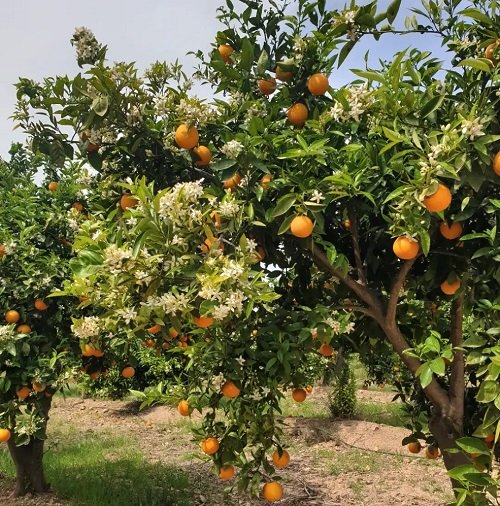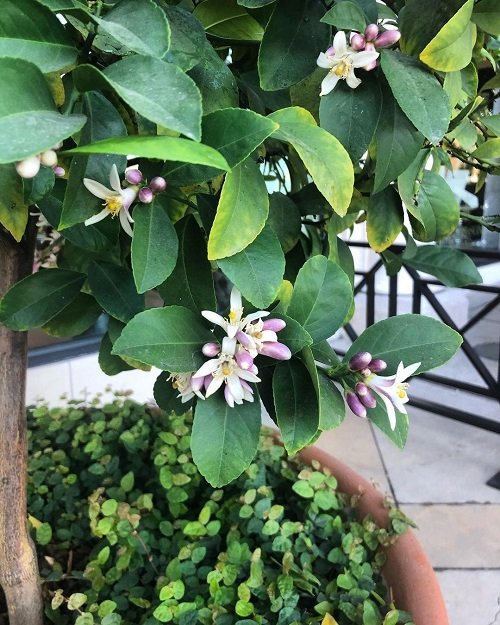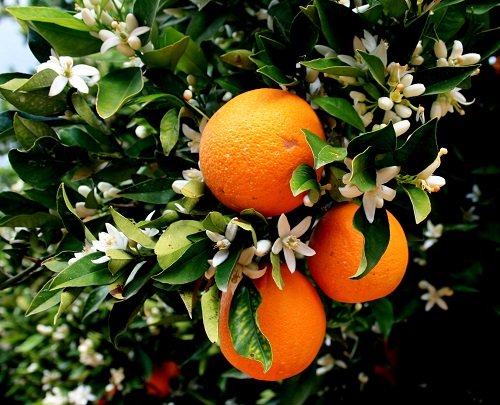Don’t know about Florida State Flower and How to Grow It? We’ve got you covered with this quick and easy guide.
Admire the fragrance and beauty of the Florida State Flower and how to grow it in your home. From growing requirements to care tips and pot size, this text will tell you everything you need to know.
Florida State Flower Information
The Florida State Flower is the beautiful Orange Blossom (Citrus sinensis).
- Appearance: The Orange Blossom, the fragrant white flower of the citrus tree, is a small and delicate blossom featuring five petal-like sepals and a prominent pistil surrounded by stamens. Its sweet citrus scent is its distinctive feature.
- Blooming Season: The Florida State Flower typically blooms in spring, specifically from March to April, signaling the start of the citrus fruit production season and perfuming the air with its captivating fragrance.
- Significance: The Orange Blossom holds cultural and economic significance in Florida. It represents fertility, prosperity, and the state’s sunny climate. Its presence is deeply intertwined with Florida’s historical ties to the citrus industry.
- Cultural Impact: The Florida State Flower is an emblem of Florida’s identity, celebrated in various cultural events, festivals, and artistic expressions. It has inspired literature, art, and music, all reflecting the state’s agricultural heritage and natural beauty.
- Legislation: Designated as Florida’s official state flower in 1909, the Orange Blossom’s recognition underlines its role in the state’s culture and economy. This designation solidified its place in Florida’s history and symbolism.
- Conservation: While not currently threatened with extinction, conserving the Florida State Flower involves maintaining healthy citrus groves and preserving natural habitats. These efforts indirectly safeguard the flower’s existence and contribute to the overall environmental balance in Florida.
Florida USDA Zones: 8a to 11a
How to Grow Florida State Flower

Growing the Florida State Flower, the Orange Blossom, can be a rewarding experience, bringing the sweet fragrance of citrus to your garden.
There are several methods to cultivate this iconic blossom, but growing it from saplings or cuttings has the best success rate. Here is how to do it.
- Choose healthy, semi-hardwood cuttings from the current year’s growth. Cuttings should be about 4 to 6 inches long and taken from a parent tree that is disease-free.
- Remove any leaves from the lower half of the cutting to reduce moisture loss. Dip the cut end in a rooting hormone to encourage root development.
- Insert the prepared cuttings into a well-draining potting mix or rooting medium. Create a humid environment by covering the cuttings with a clear plastic bag or using a propagation dome.
- Place the cuttings in a bright, indirect light location. Keep the rooting medium consistently moist but not waterlogged. Roots typically develop in a few weeks to a few months.
- Once the cuttings have developed a healthy root system, they can be transplanted into individual pots or directly into the garden.
Best Pot Size for Florida State Flower
A pot with a diameter of at least 12 to 16 inches and a depth of about 18 inches is recommended for the Florida State Flower tree. As the plant matures, it might require a larger container (One or two sizes bigger than the old one) to accommodate its increasing root system.
A properly sized pot not only supports the plant’s growth but also prevents the risk of root-bound conditions and ensures the Orange Blossom can thrive and display its fragrant blossoms in a container gardening setting.
Here are Plant Pot Sizes from Inches to Gallon
Requirements for Growing Florida State Flower

Sunlight
- Intensity: The Florida State Flower thrives in full sunlight, requiring at least 6 to 8 hours of direct sunlight daily to support robust growth and abundant flowering.
- Location: Choose a sunny spot for your Orange Blossom, preferably south or southwest-facing, to ensure it receives ample sunlight throughout the day, promoting healthy development and the iconic fragrant blossoms.
Soil
Soil Type: The Florida State Flower prefers well-draining soil that retains moisture without becoming waterlogged. A mix of sandy loam and organic matter provides the ideal balance of drainage and moisture retention for healthy root development.
pH Level: Maintain a slightly acidic to neutral soil pH range of 6.0 to 7.0 for optimal Orange Blossom growth. This pH range ensures proper nutrient availability and uptake, contributing to vibrant foliage and abundant flowering. Regularly testing and adjusting the soil pH as needed will help create a favorable environment for the plant’s success.
Arizona State Flower and How to Grow It
Water
Frequency: Provide consistent moisture to the Orange Blossom without allowing the soil to become waterlogged. Water deeply and thoroughly, allowing the top inch of soil to dry before watering again. During the growing season, frequent watering might be necessary, particularly during hot and dry periods.
Method: When watering Florida State Flower, use a method that ensures deep penetration of water into the root zone. Drip irrigation or a soaker hose placed at the base of the plant is ideal, as it minimizes water on the foliage and helps prevent diseases. Avoid overhead watering, especially in the evening, as wet foliage overnight can lead to fungal issues.
Temperature
Range: The plant thrives in a warm climate and is well-suited to USDA hardiness zones 9 through 11. It prefers temperatures between 55°F (13°C) and 90°F (32°C) for healthy growth and flowering.
Protection: Protect the Florida State Flower from frost and cold temperatures, as it is sensitive to freezing conditions. If you live in a region prone to frost, consider planting the tree near a south-facing wall or using frost cloth during colder periods.
Florida State Flower Care

Fertilizer
Apply a high-quality citrus or fruit tree fertilizer with a balanced N-P-K (nitrogen, phosphorus, and potassium) ratio. Begin fertilizing in early spring before new growth emerges, and continue every 6 to 8 weeks during the growing season until late summer.
Avoid over-fertilization, as it can lead to excessive foliage growth at the expense of blossoms. Following recommended application rates and adjusting based on soil conditions and plant response will help ensure that the Florida State Flower receives the necessary nutrients for optimal development and the production of its signature fragrant blooms.
Pests
- Aphids: Tiny insects that feed on plant sap, causing distorted growth and excreting honeydew, which can attract other pests.
- Whiteflies: Small, winged insects that suck sap from leaves, leading to wilting and yellowing, and can also transmit plant diseases.
- Scale Insects: These insects attach themselves to stems and leaves, sucking plant juices and causing weak growth, yellowing, and a sticky substance known as honeydew.
- Citrus Leafminer: Larvae tunnel into leaves, creating silvery trails and causing leaf distortion, affecting the plant’s aesthetics and photosynthesis.
- Citrus Rust Mite: Tiny mites that cause rust-colored spots on leaves, reducing the plant’s vigor and overall health.
Diseases
- Citrus Canker: Bacterial disease causing raised lesions on leaves, fruit, and stems, leading to premature fruit drop and defoliation.
- Citrus Greening (Huanglongbing): Bacterial disease transmitted by insects, causing yellowing, stunted growth, and bitter, misshapen fruit.
- Brown Rot: Fungal infection leading to brown, decaying spots on fruit, causing fruit drop and reducing quality.
- Alternaria Brown Spot: Fungal disease causing dark, circular spots with yellow halos on leaves and fruit.
- Melanose: Fungal infection resulting in raised, dark lesions on leaves and fruit, affecting appearance and quality.
Illinois State Flower and How to Grow It
FAQs
1. Can I Grow the Florida State Flower Indoors?
While Orange Blossoms thrive in full sunlight, you can grow them indoors if you provide bright, direct light near a sunny window.
2. How Do I Ensure My Florida State Flower Survives Cold Winters?
If frost is a concern, consider wrapping the plant with frost cloth or burlap, using mulch to insulate the root zone, and positioning the tree near a south-facing wall for added warmth.
3. Florida State Flower Companion Plants
You can companion plant Florida State Flower with other citrus-friendly flowers like marigolds or herbs like basil. These plants can provide added benefits such as pest control and attracting pollinators.




